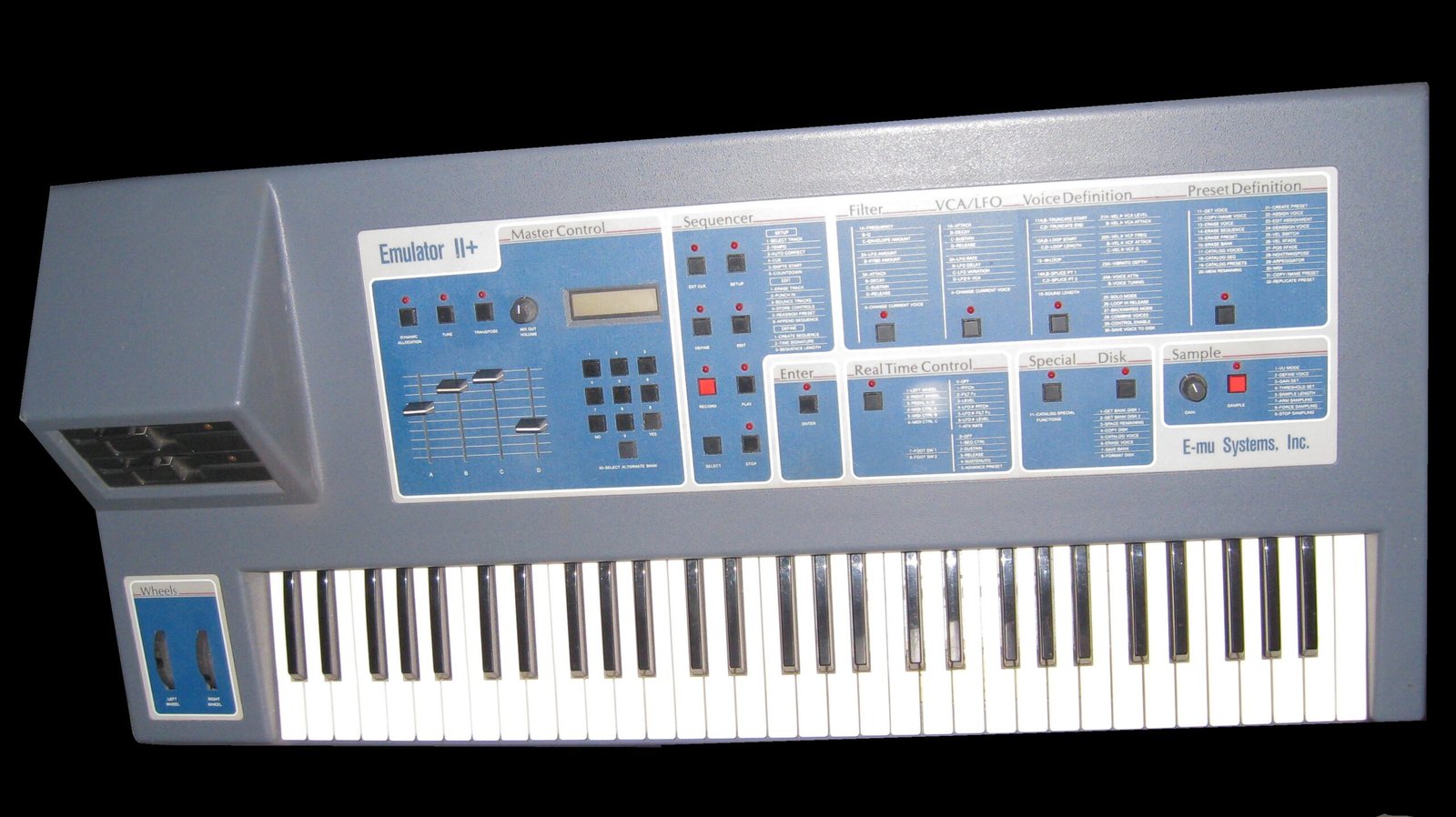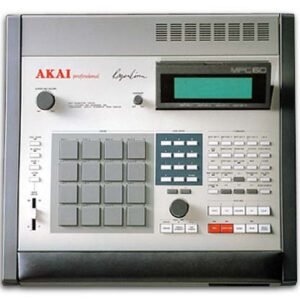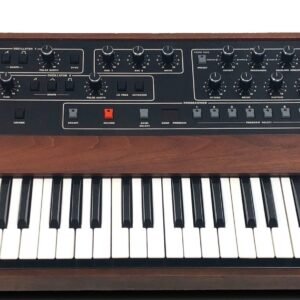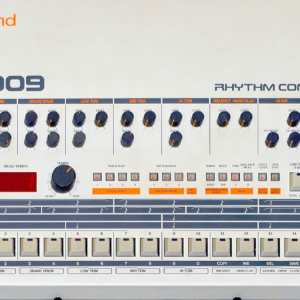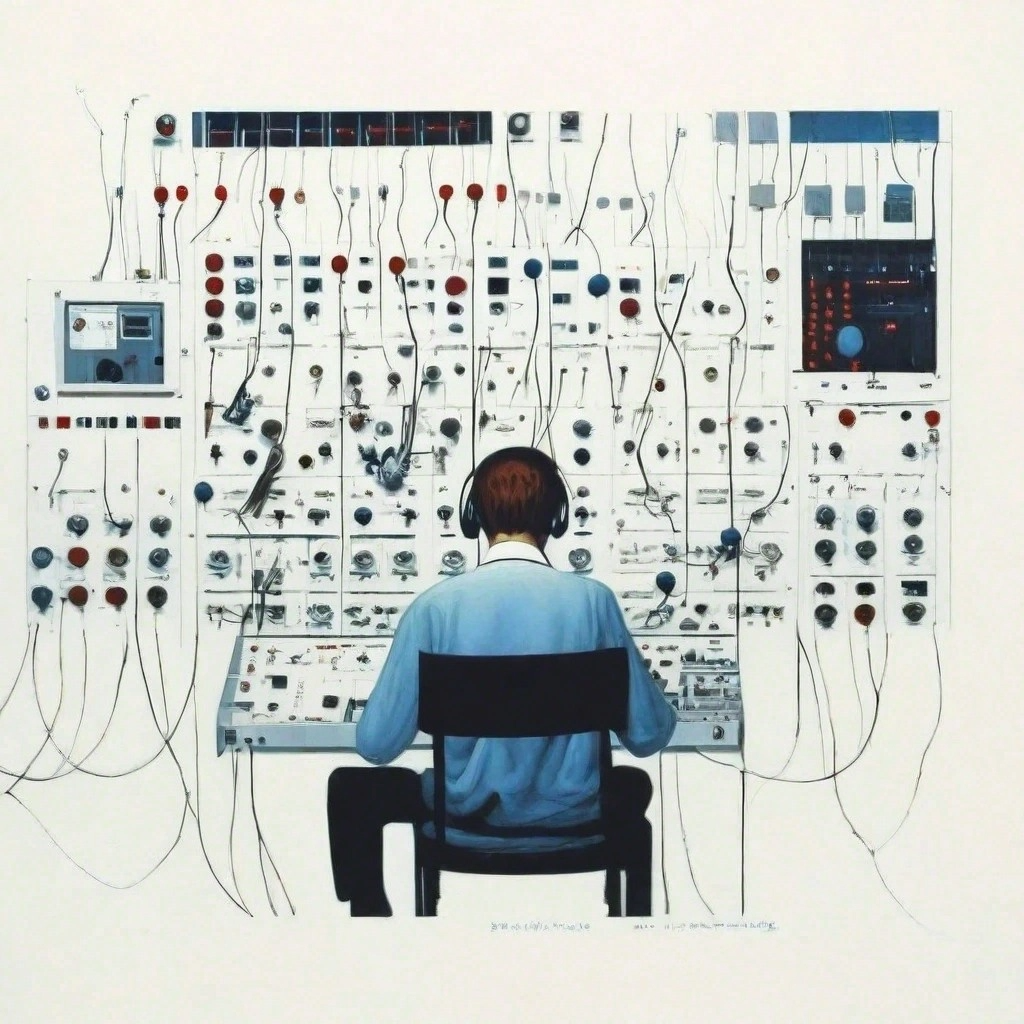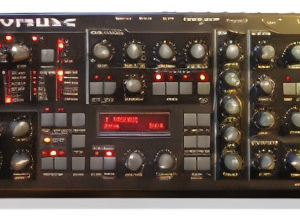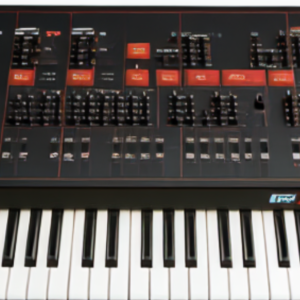Emu Emulator II
EMU Emulator II, often stylized as Emulator II, stands as an emblem of the digital sampling revolution of the 1980s. Developed by E-mu Systems, the Emulator II transcended the boundaries of traditional synthesis by introducing the concept of sampling to a wider audience, forever altering the landscape of music production.
Released in 1984, the Emulator II quickly gained acclaim for its groundbreaking capabilities, allowing musicians to sample real-world sounds and manipulate them within a musical context. Its introduction marked a pivotal moment in the history of electronic music, paving the way for the sampling culture that would dominate the decades to come.
The Emulator II was not merely a synthesizer; it was a sampler, a digital instrument that could capture and reproduce the nuances of acoustic instruments, voices, and any other sound imaginable. This transformative technology empowered musicians to create entirely new sonic landscapes, blending the organic with the electronic in ways previously unimagined.
In this article, we delve into the origins, design, and impact of the Emulator II, exploring its contributions to music production, its influence on popular culture, and its enduring legacy among musicians and enthusiasts alike. Join us as we embark on a journey through the revolutionary world of the Emulator II.
Design and Features
The Emulator II boasted a design that was both sleek and functional, embodying the aesthetic of cutting-edge technology prevalent in the 1980s. Its interface featured a combination of tactile controls, a graphical display, and an array of buttons, providing users with intuitive access to its powerful sampling and synthesis capabilities.
One of the standout features of the Emulator II was its sampling engine, which allowed musicians to capture audio from external sources and manipulate it in real-time. With a sampling rate of 27.7 kHz and 12-bit resolution, the Emulator II delivered sound quality that was considered top-notch at the time, capturing the nuances and dynamics of the original recordings with impressive fidelity.
The Emulator II also offered generous storage capacity for its samples, with models featuring up to 8 MB of memory, allowing users to store a vast library of sounds for instant access during performances and studio sessions. This storage capacity was a significant improvement over its predecessor, the Emulator I, and contributed to the Emulator II’s popularity among musicians and producers.
In terms of synthesis capabilities, the Emulator II featured a versatile sound engine that included a variety of digital filters, envelope generators, and modulation options. This allowed users to sculpt and shape their sampled sounds with precision, creating rich and complex textures that could be tailored to suit a wide range of musical styles and genres.
The Emulator II also featured a built-in sequencer, enabling users to create intricate musical arrangements directly within the instrument. This sequencer offered a range of editing tools and performance features, allowing musicians to compose, arrange, and perform their music with ease.
In addition to its technical capabilities, the Emulator II also made a statement with its design aesthetics. Its sleek black chassis, backlit buttons, and graphical display exuded a sense of sophistication and professionalism, making it a visually striking addition to any studio or stage setup.
Overall, the Emulator II’s combination of advanced sampling technology, powerful synthesis capabilities, and intuitive design made it a groundbreaking instrument that played a pivotal role in shaping the sound of music in the 1980s and beyond. Its influence can still be felt today, with many artists and producers continuing to utilize its iconic sounds and features in their work.
Sound Generation
The Emulator II revolutionized sound generation by introducing the concept of digital sampling to the world of music production. Unlike traditional synthesizers that relied on oscillators and waveform generation, the Emulator II allowed users to capture real-world sounds and manipulate them in a digital environment.
At the heart of the Emulator II’s sound generation capabilities was its sampling engine, which enabled users to record audio from external sources such as acoustic instruments, vocals, or environmental sounds. These samples could then be stored in the instrument’s memory and played back at different pitches, durations, and with various processing effects applied.
The Emulator II offered a range of sampling options, allowing users to capture sounds with different sampling rates and resolutions to achieve the desired balance between sound quality and memory usage. With a sampling rate of 27.7 kHz and 12-bit resolution, the Emulator II delivered sound quality that was considered impressive for its time, capturing the nuances and timbres of the original recordings with remarkable fidelity.
Once samples were loaded into the Emulator II, users had access to a variety of editing and manipulation tools to shape and sculpt the sound to their liking. This included features such as looping, trimming, and crossfading, as well as a selection of digital filters, envelopes, and modulation options for further sonic manipulation.
The Emulator II also offered polyphonic playback, allowing users to layer multiple samples together to create rich and complex textures. This polyphony, combined with the instrument’s advanced sound processing capabilities, enabled musicians to create a wide range of sounds and textures that were previously unattainable with traditional synthesizers.
In addition to its sampling capabilities, the Emulator II also featured a selection of built-in sounds and presets, ranging from realistic emulations of acoustic instruments to futuristic synth tones and sound effects. These presets served as a starting point for exploration and experimentation, providing users with instant access to a diverse palette of sounds for use in their compositions.
Overall, the Emulator II’s innovative approach to sound generation played a significant role in shaping the sonic landscape of the 1980s and beyond. Its ability to capture and manipulate real-world sounds opened up new creative possibilities for musicians and producers, paving the way for the sampling culture that would come to define modern music production.
Technical Specifications
The technical specifications of the Emulator II highlight its capabilities as a pioneering digital sampling instrument, setting new standards for sound quality, memory capacity, and performance features in the 1980s music technology landscape.
Sampling Engine:
Sampling Rate: 27.7 kHz
Resolution: 12-bit
Dynamic Range: Approximately 90 dB
Memory Capacity:
Standard Memory: 512 KB
Expandable Memory: Up to 8 MB (with optional RAM expansion)
Polyphony:
Polyphonic Voices: Up to 8 voices
Note Resolution: 16-bit
Storage:
Internal Storage: Floppy disk drive (3.5-inch)
External Storage: SCSI interface for additional storage devices
User Interface:
Display: Backlit graphical display
Controls: Tactile buttons, rotary encoders, and sliders for parameter adjustment
Connectivity:
Audio Outputs: Stereo main outputs (RCA)
Audio Inputs: Mono/stereo sampling inputs (quarter-inch jacks)
MIDI: MIDI In/Out/Thru ports for communication with other MIDI-compatible devices
Sound Processing:
Filters: Digital low-pass, high-pass, and band-pass filters
Envelopes: ADSR envelope generators for shaping the amplitude and timbre of sounds
LFOs: Low-frequency oscillators for modulation effects such as vibrato and tremolo
Sequencer:
Built-in Sequencer: Multi-track sequencer with real-time recording and editing capabilities
Resolution: 96 PPQN (Pulses Per Quarter Note)
Physical Dimensions:
Dimensions (W x D x H): Approximately 19 x 15 x 5 inches
Weight: Approximately 20 pounds
Power Supply:
Voltage: 100-120V or 220-240V AC, 50/60 Hz
Power Consumption: Approximately 25 watts
Additional Features:
Performance Controls: Pitch bend and modulation wheels
Presets: Factory presets and user-programmable patches for instant sound access
Expansion Options: Compatibility with additional sound libraries and expansion cards
The Emulator II’s technical specifications demonstrate its versatility and sophistication as a digital sampling instrument, offering musicians and producers a powerful tool for sound creation, manipulation, and performance. Its combination of advanced sampling technology, intuitive user interface, and expandable memory capacity cemented its status as an iconic instrument in the history of electronic music.
Performance and Workflow
The Emulator II’s performance capabilities and workflow revolutionized music production in the 1980s, providing musicians with unprecedented flexibility and control over their sound. From live performances to studio sessions, the Emulator II offered a seamless integration of sampling, synthesis, and sequencing, empowering users to unleash their creativity with ease.
Sampling Workflow:
Sampling Process: The Emulator II streamlined the sampling process, allowing users to capture audio from external sources quickly and efficiently. With its intuitive interface and real-time monitoring capabilities, users could sample sounds on the fly and instantly preview the results before finalizing the recording.
Editing Tools: Once samples were captured, the Emulator II offered a comprehensive suite of editing tools for refining and shaping the sound to perfection. From trimming and looping to crossfading and time-stretching, users could manipulate their samples with precision, ensuring they fit seamlessly into their compositions.
Synthesis Capabilities:
Sound Design: In addition to its sampling capabilities, the Emulator II featured a versatile synthesis engine that allowed users to create and manipulate sounds from scratch. With a variety of digital filters, envelopes, and modulation options, users could sculpt and shape their sounds with precision, unlocking endless creative possibilities.
Presets and Patches: The Emulator II came loaded with a wide range of factory presets and user-programmable patches, providing users with instant access to a diverse palette of sounds for use in their compositions. Whether they needed realistic instrument emulations or futuristic synth tones, the Emulator II had them covered.
Sequencing and Performance:
Built-in Sequencer: The Emulator II featured a built-in multi-track sequencer that allowed users to create intricate musical arrangements directly within the instrument. With real-time recording and editing capabilities, users could compose, arrange, and perform their music with ease, whether in the studio or on stage.
Performance Controls: To enhance the live performance experience, the Emulator II included performance controls such as pitch bend and modulation wheels, allowing users to add expressive nuances to their playing in real-time. These controls added a dynamic dimension to performances, enabling users to inject personality and emotion into their music.
Integration and Connectivity:
MIDI Compatibility: The Emulator II was equipped with MIDI In/Out/Thru ports, allowing seamless integration with other MIDI-compatible devices such as synthesizers, drum machines, and sequencers. This facilitated expanded creative possibilities and enabled users to synchronize their setups for cohesive performances and productions.
External Storage: With its SCSI interface, the Emulator II supported external storage devices, enabling users to expand their storage capacity and access additional sound libraries and samples. This flexibility ensured that users had ample resources at their disposal to fuel their creativity and experimentation.
Overall, the Emulator II’s performance capabilities and workflow enhancements made it a game-changer in the world of music production, empowering musicians and producers to push the boundaries of creativity and expression. Its intuitive interface, powerful synthesis engine, and seamless integration of sampling and sequencing laid the groundwork for the digital music revolution that continues to shape the industry today.
Notable Users and Influences
The Emulator II’s impact on music production reverberated across genres and generations, influencing a diverse array of artists and leaving an indelible mark on popular culture. From pioneering electronic musicians to mainstream pop stars, the Emulator II found its way into the hands of countless artists who embraced its revolutionary sampling capabilities and distinctive sound.
Electronic Music Pioneers:
Depeche Mode: Renowned for their innovative use of synthesizers and samplers, Depeche Mode integrated the Emulator II into their iconic sound during the 1980s. Tracks like “Enjoy the Silence” and “Personal Jesus” feature signature Emulator II sounds, contributing to the band’s enduring legacy in electronic music.
Jean-Michel Jarre: As a pioneer of electronic music, Jean-Michel Jarre utilized the Emulator II to create lush, atmospheric textures and cinematic soundscapes in his groundbreaking compositions. Albums like “Oxygène” and “Équinoxe” showcase the Emulator II’s versatility and its ability to evoke otherworldly sonic landscapes.
Hip-Hop and Sampling Culture:
Public Enemy: The Emulator II played a significant role in the emergence of sampling culture in hip-hop music, with groups like Public Enemy using its sampling capabilities to craft innovative beats and incorporate diverse sonic elements into their tracks. The Emulator II’s influence can be heard on seminal albums like “It Takes a Nation of Millions to Hold Us Back.”
Beastie Boys: Known for their eclectic style and genre-blurring approach to music, the Beastie Boys embraced the Emulator II’s sampling capabilities to create groundbreaking hip-hop tracks that fused rock, funk, and punk influences. Songs like “Paul Revere” and “Brass Monkey” feature distinctive Emulator II samples that helped define the group’s sound.
Film and Television Scores:
Hans Zimmer: Esteemed composer Hans Zimmer utilized the Emulator II extensively in his film scores, leveraging its rich sampling capabilities to create immersive soundtracks that complemented the visual storytelling on screen. From “Rain Man” to “The Dark Knight,” Zimmer’s use of the Emulator II helped shape the sonic landscapes of some of cinema’s most iconic films.
Tangerine Dream: Pioneering electronic band Tangerine Dream incorporated the Emulator II into their atmospheric soundtracks for films like “Risky Business” and “Legend,” contributing to the emergence of electronic music as a prominent force in film scoring. The Emulator II’s ethereal textures and evocative soundscapes added depth and emotion to their cinematic compositions.
Pop Icons:
Madonna: Pop icon Madonna embraced the Emulator II’s cutting-edge sound in her music during the 1980s, incorporating its distinctive samples and textures into hits like “Like a Prayer” and “Vogue.” The Emulator II’s presence in Madonna’s music helped define the sound of pop music in the era and solidified its place in popular culture.
Prince: Renowned for his boundary-pushing approach to music production, Prince utilized the Emulator II to augment his eclectic sound with sampled instruments and innovative textures. Tracks like “When Doves Cry” and “Sign o’ the Times” feature prominent Emulator II sounds, showcasing its versatility and influence in shaping Prince’s iconic sound.
Overall, the Emulator II’s notable users and influences spanned a wide range of musical genres and creative disciplines, cementing its status as an iconic instrument that left an indelible mark on music history. From electronic pioneers to mainstream pop stars, the Emulator II’s revolutionary sampling capabilities and distinctive sound continue to inspire and captivate artists around the world.
Impact and Legacy
The Emulator II’s impact on music production and its enduring legacy are profound, shaping the course of electronic music and influencing generations of musicians, producers, and enthusiasts alike. Its revolutionary sampling capabilities, innovative design, and distinctive sound left an indelible mark on popular culture, paving the way for the digital music revolution that continues to shape the industry today.
Revolutionizing Music Production:
The Emulator II democratized music production by introducing sampling technology to a wider audience, empowering musicians to capture, manipulate, and create sounds in ways that were previously unimaginable.
Its intuitive interface and powerful features streamlined the production process, making it accessible to artists of all backgrounds and skill levels, from aspiring bedroom producers to seasoned studio professionals.
Shaping Musical Genres:
The Emulator II played a pivotal role in the evolution of various musical genres, from electronic and hip-hop to pop and film scoring. Its distinctive sound became synonymous with the music of the 1980s, contributing to the sonic landscape of the era and shaping the sound of countless hits and iconic compositions.
Artists across genres embraced the Emulator II’s sampling capabilities, incorporating its signature sounds into their music and pushing the boundaries of creativity and experimentation.
Cultural Icon and Symbol of Innovation:
As a cultural icon, the Emulator II symbolized the cutting-edge technology and innovation of its time, embodying the spirit of musical exploration and technological advancement that defined the 1980s.
Its sleek design, intuitive interface, and distinctive sound made it a coveted instrument among musicians and producers, solidifying its place in popular culture and cementing its status as an iconic symbol of electronic music.
Continued Influence and Reverence:
Despite the passage of time, the Emulator II’s influence continues to resonate in modern music production, with artists and producers still drawn to its distinctive sound and pioneering features.
Its legacy lives on through software emulations, hardware recreations, and sample libraries that pay homage to its iconic sound, ensuring that its impact on music will be felt for generations to come.
In conclusion, the Emulator II’s impact and legacy are undeniable, reshaping the landscape of music production and leaving an indelible mark on popular culture. From its groundbreaking sampling capabilities to its iconic design and enduring influence, the Emulator II remains a symbol of innovation and inspiration for musicians and enthusiasts around the world.
Collector's Value and Market Trends
The Emulator II holds a significant place in the hearts of musicians, collectors, and enthusiasts, leading to a thriving market for vintage synthesizers and samplers. As a pioneering instrument that helped shape the sound of the 1980s, the Emulator II has become a sought-after collector’s item, with its rarity, historical significance, and distinctive sound contributing to its enduring appeal.
Collector’s Value:
The Emulator II’s status as a vintage synthesizer and sampler contributes to its collector’s value, with enthusiasts eager to own a piece of music history.
Well-preserved Emulator II units in good working condition can fetch premium prices on the vintage synthesizer market, particularly those with original factory presets, documentation, and accessories.
Rarity and Availability:
Due to its age and limited production run, the Emulator II is relatively rare compared to more mass-produced synthesizers of its era. This scarcity adds to its collector’s value and contributes to its allure among enthusiasts.
While some Emulator II units may surface on the secondhand market from time to time, finding one in pristine condition with all original components intact can be a challenge, further enhancing its desirability among collectors.
Historical Significance:
The Emulator II’s role in shaping the sound of 1980s music and its influence on electronic music production contribute to its historical significance, elevating its status as a collectible instrument.
Music historians, collectors, and enthusiasts recognize the Emulator II as a groundbreaking instrument that played a pivotal role in the evolution of music technology, making it a prized addition to any vintage synthesizer collection.
Market Trends:
Demand for vintage synthesizers like the Emulator II remains strong, driven by nostalgia, appreciation for analog and digital synthesis, and the desire to own iconic instruments from music history.
Prices for Emulator II units can vary depending on factors such as condition, rarity, and included accessories. Mint-condition units with original packaging and documentation may command higher prices than well-used units with signs of wear and tear.
The Emulator II’s market value may fluctuate over time based on supply and demand dynamics, as well as broader trends in the vintage synthesizer market. However, its status as a sought-after collector’s item ensures that interest in the instrument remains high among collectors and enthusiasts alike.
In conclusion, the Emulator II’s collector’s value and market trends reflect its status as a revered vintage synthesizer and sampler with historical significance and enduring appeal. As demand for vintage synthesizers continues to grow, the Emulator II remains a coveted instrument for collectors and enthusiasts seeking to own a piece of music history.
Innovations and Contributions
The Emulator II stands as a pioneering instrument that introduced groundbreaking innovations to the world of music production, leaving a lasting legacy and making significant contributions to the evolution of electronic music technology. From its revolutionary sampling capabilities to its intuitive interface and iconic sound, the Emulator II pushed the boundaries of creativity and paved the way for new sonic possibilities.
Sampling Technology:
Perhaps the most significant innovation of the Emulator II was its introduction of sampling technology to a wider audience of musicians and producers. By allowing users to capture, manipulate, and play back real-world sounds, the Emulator II revolutionized the way music was created, opening up new avenues of sonic exploration and experimentation.
The Emulator II’s sampling engine, with its 12-bit resolution and 27.7 kHz sampling rate, delivered sound quality that was considered exceptional for its time, capturing the nuances and dynamics of the original recordings with remarkable fidelity.
Intuitive Interface:
The Emulator II featured an intuitive interface that streamlined the music production process, making it accessible to musicians of all skill levels. With its tactile controls, graphical display, and straightforward workflow, the Emulator II empowered users to harness the power of sampling technology without the need for extensive technical knowledge or expertise.
Its user-friendly design contributed to its widespread adoption and popularity among musicians and producers, cementing its status as a groundbreaking instrument in the history of electronic music technology.
Versatile Synthesis Capabilities:
In addition to its sampling capabilities, the Emulator II boasted a versatile synthesis engine that allowed users to create and manipulate sounds with precision. With a variety of digital filters, envelopes, and modulation options, users could sculpt and shape their sounds to suit a wide range of musical styles and genres.
The Emulator II’s synthesis capabilities complemented its sampling features, providing users with a comprehensive toolkit for sound design and manipulation that was unparalleled at the time.
Impact on Music Production:
The Emulator II’s innovations had a profound impact on music production, shaping the sound of countless hits and influencing the evolution of electronic music genres such as synth-pop, hip-hop, and electronic dance music (EDM). Its distinctive sound became synonymous with the music of the 1980s, contributing to the sonic landscape of the era and inspiring generations of musicians and producers.
Its influence continues to be felt in modern music production, with artists and producers still drawn to its iconic sound and pioneering features. From software emulations to hardware recreations, the legacy of the Emulator II lives on, ensuring that its contributions to music technology will be remembered and celebrated for years to come.
In conclusion, the Emulator II’s innovations and contributions to music technology have left an indelible mark on the world of electronic music, reshaping the way music is created, produced, and consumed. Its revolutionary sampling capabilities, intuitive interface, and versatile synthesis engine have inspired generations of musicians and producers, solidifying its place as an iconic instrument in the history of music technology.
Conclusion
The Emulator II stands as a beacon of innovation and creativity in the world of music technology, leaving an indelible mark on the history of electronic music production. From its pioneering sampling capabilities to its intuitive interface and iconic sound, the Emulator II revolutionized the way music was created, pushing the boundaries of sonic exploration and paving the way for new artistic possibilities.
Throughout its storied history, the Emulator II has continued to inspire generations of musicians, producers, and enthusiasts, shaping the sound of countless hits and leaving a lasting legacy that endures to this day. Its impact on music production cannot be overstated, as it played a pivotal role in the evolution of electronic music genres such as synth-pop, hip-hop, and EDM, influencing the sonic landscape of the 1980s and beyond.
As a collector’s item, the Emulator II holds a special place in the hearts of music aficionados, with its rarity, historical significance, and distinctive sound contributing to its enduring appeal. Its contributions to music technology continue to be celebrated and revered, with artists and producers still drawn to its iconic sound and pioneering features.
In conclusion, the Emulator II’s legacy as a groundbreaking instrument and cultural icon is secure, as it continues to inspire creativity, innovation, and musical exploration in the ever-evolving landscape of electronic music production. Its timeless appeal and lasting influence serve as a testament to the enduring power of innovation and imagination in the world of music.
